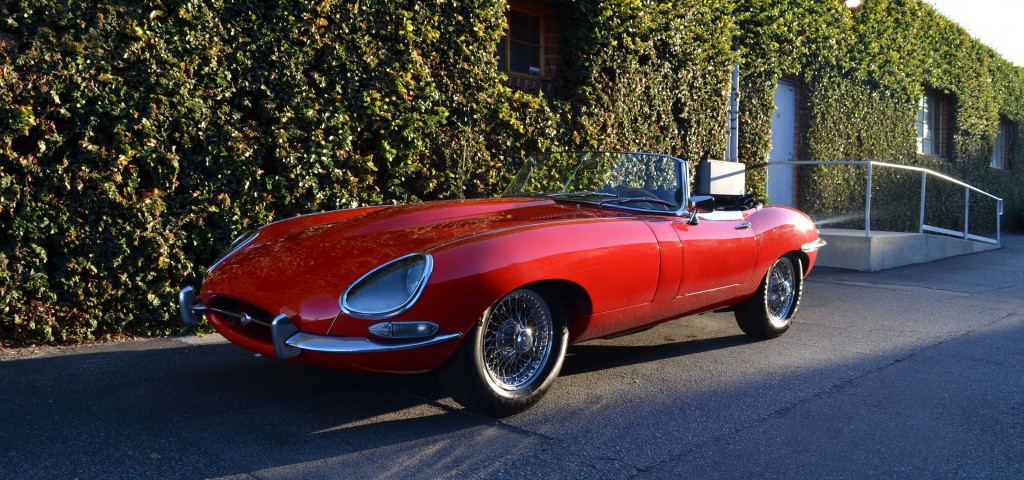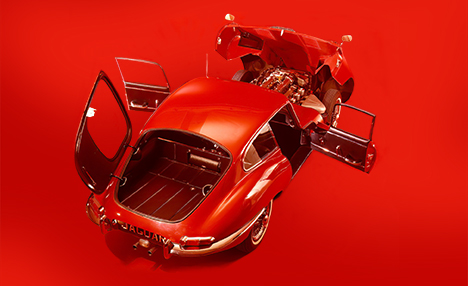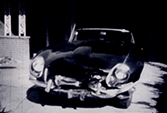The 1950s were halcyon days for Jaguar. With postwar demand for sports cars reaching record levels, Jaguar’s iconic XK120 two-seater quickly became a must-have amongst the American and European “sporty” car set. Alongside success in the showrooms, the decade also marked a period of near total domination by Jaguar in endurance racing, including 24 Hours of Le Mans victories in 1951, 1953, 1955, 1956 & 1957. Continued success on the track was becoming more difficult to achieve in the face of more technologically advanced competitors and the iconic XK range was beginning to look dated when compared to products from Aston Martin, Ferrari, Maserati, Mercedes-Benz and Porsche.

Repeated surveys confirm that the E-Type is the most revered British sports car ever built and one of a handful of design icons
Jaguar withdrew its factory-sponsored racecars after the 1956 Le Mans triumph and the competition department was tasked with the design of a new sports car based on the racing cars that owned the Maison Blanc and the Mulsanne Straight. The resulting E-Type was a direct descendant of the D-Type that had won the World Sports Car Championship and shared its XK engine, disc brakes and semi-monocoque chassis design while clothed in an aerodynamic envelope artfully fashioned by Malcolm Sayer.
It was the beautifully sleek profile over advanced mechanicals that would cement the E-Type’s reputation as an automotive hallmark. It was the equivalent of finding out that the supermodel for which you’ve pined was also an honors graduate with an affinity for small animals, children and charitable works. The new Jaguar would forever mark the transition from the conservative 50s into the sexy 60s and prepare the world for Ursula Andress, Brigitte Bardot and Raquel Welch. Following its launch at the 1961 Geneva Auto Show, Enzo Ferrari proclaimed the new cat as “The most beautiful car ever made” and, in time, it would grace the Museum of Modern Art in New York and sit atop the list of the “100 Most Beautiful Cars of All Time.”
An Affordable Thrill Ride
What was truly incredible about the car was not the curvaceous body, nor the world-class suspension, but the fact that it was downright affordable when compared to its peers – at less than half the cost of the Aston Martin DB4 GT you got better performance and handling. Within four months after its debut at Geneva, the Jaguar E-Type was available for purchase in roadster and coupe variants and capable of 150 mph (although few owners could replicate the feat) from its 3.8-liter twin overhead camshaft engine that had more than proved its worth in competition.
The initial version of the car powered by the 3.8 sold briskly with 15,498 purchased in the three years following its launch. An enlarged 4.2-liter engine was introduced with the “Series 1” with more torque, better brakes and a significantly improved gearbox that now featured synchromesh on all forward gears. A 2+2 variant followed in 1966 boasting rear jump seats and an available automatic transmission to go along with its greater length.
Under pressure from increasingly onerous federal regulations, Jaguar created the “Series 1½” from 1967-1968 with more effective (but far less pretty) open headlights, improved dash switches and new carburetion to meet emissions standards. In total, 38,419 examples were sold through the end of the Series 1½ cars when the heavy-handed regulators squeezed the sexy feline even further.
The Series 2 was sold from 1969 to 1971 and adopted many of the features unveiled on its immediate predecessor plus larger and higher bumpers and turn signal indicators. The brake lights went from delicate to garish (and as many sexy bits eventually fall prey, migrated south – to under the bumpers) and the mouth opening was increased in size to assist in engine cooling (helped by supplemental fans) while fragile Americans were protected by the replacement of the toggles by safer rocker-style dash switches. Brakes continued to improve while air conditioning and power steering were newly available from the factory. While emissions controls and added weight hampered performance the car continued to resonate with buyers (with 18,809 car sold).
To offset the loss in performance dictated by compliance with federal regulations, Jaguar responded with an all-new 5.3-liter V-12 in 1971. The engine added only 80 pounds to the car and boasted excellent acceleration, refinement and torque. What it added in these qualities, however, detracted from the essential nature of the car, which grew softer and more luxurious with each passing year and foretold the coming of the XJ-S in 1975.
Driven
More than 50 years after its debut, the E-Type retains its visceral sensuality and the shape is compelling now as then. The 1965 E-Type OTS Series 1 that we drove is at once both feminine and phallic and is the embodiment of the sexually liberated decade of its birth. The car stands low to the ground although none of the contortion required of entering a coupe is necessary with the top lowered. The interior is trimmed in high-quality black leather of recent vintage and features all the elements that make for memorable sports cars – full instrumentation, firm seating and performance far in excess of its saloon car relatives. From the start, the venerable XK engine is familiar with a note that is restrained at idle and joyous at speed. One of the most interesting features of the XK powerplant is that as displacement increased throughout its lifespan (1948 to 1992) it grew more flexible and tractable rather than less so.
The gearbox is familiar to anyone that has spent any time in British cars with its long handle and positive throws, while the transmission allows for quick shifts and well-spaced ratios. The clutch pedal is firm but easy to depress and the pedals are well spaced to allow for heel and toe operation. The brakes are as good as any offered during the period and the pedal operates with servo assistance that allows for firm (rather than excessive pressure). The braking is progressive and neither overwhelms the suspension in hard use nor elicits fade from repeated stopping.

The perfect sports car cockpit trimmed in luxurious leather and with some of the best ergonomics from the 60s
The steering wheel is (like the rest of the car) beautiful but its use is somewhat heavy in traffic. At speed the effort to control the car is almost perfect and it is easy to see the gauges through the wheel and the gearbox lever falls easily to reach. The performance of the car remains exceptional even when compared with modern commuters that can nominally match its statistics. It is as much a case of how the E-Type goes about its job, as it is what the E-Type does as a car.
The E-Type is the rare classic that can be driven anywhere at anytime (especially in coupe form with open headlights – the closed headlight models are almost unusable at night due to visibility concerns) and rewards the driver with exceptional performance in the here and now rather than wistfully reminding us how much has changed in the intervening decades. The car not only keeps up with traffic but also accelerates away from it and handles as well as one could hope for while riding on narrow tires with wire wheels. It never feels twitchy in transition and feels benign at the limits, which most drivers will explore.
What settles the question, however, is the view over the hood that is, perhaps, the most compelling factor presented to the enthusiast driver. While at a stoplight, other drivers nod approvingly and appreciate its beauty despite the passage of time. There are few sports cars that everyone should own at one time or another, but the Jaguar E-Type should reside near the top of the list. It remains relevant today, will be tomorrow, and constantly serves as a reminder of an automotive legend whose beauty will never fade.
 Sampled – Few cars have undergone as meteoric a rise in value as has the E-Type in recent years, with even previously unloved Series III cars now routinely passing the $100,000 threshold at auction. From the standpoint of collectability, desirability and aesthetics, the best of the breed are the Series I closed headlamp cars in either FHC or OTS trim. While this particular model wears a flattering red – instead of the original white and has a non-original block – these are advantages in that it keeps the price reasonable unlike the $200,000-250,000 that 100-point cars now command. Most of us can no longer afford such scratch, but nonetheless we would prefer a driver condition closed headlamp E-Type like this since every mile driven would add smiles rather than detract from the car’s value as would be the case with a concours standard example. Thanks to Chequered Flag International in Marina Del Rey, California for throwing us the keys to the most popular British sports car ever.
Sampled – Few cars have undergone as meteoric a rise in value as has the E-Type in recent years, with even previously unloved Series III cars now routinely passing the $100,000 threshold at auction. From the standpoint of collectability, desirability and aesthetics, the best of the breed are the Series I closed headlamp cars in either FHC or OTS trim. While this particular model wears a flattering red – instead of the original white and has a non-original block – these are advantages in that it keeps the price reasonable unlike the $200,000-250,000 that 100-point cars now command. Most of us can no longer afford such scratch, but nonetheless we would prefer a driver condition closed headlamp E-Type like this since every mile driven would add smiles rather than detract from the car’s value as would be the case with a concours standard example. Thanks to Chequered Flag International in Marina Del Rey, California for throwing us the keys to the most popular British sports car ever.









'Driven – 1965 Jaguar E-Type OTS' have 3 comments
November 13, 2015 @ 10:14 am Willam Earl
I have owned and driven daily a 1969 E-Type OTS for over 12 years. It has original pressed steel (not wire) wheels, and slightly wider tires than stock. Despite the somewhat lower horsepower than the tested car, it also leaves most other cars behind, and the handling inspires confidence in all conditions, including mud and snow. The pressed steel wheels with the wider tires largely eliminate any wobbling on rough corners. I have a hardtop for winter, which makes the car more like a coupe in cold weather (quieter and warmer).
March 18, 2016 @ 6:53 am Brian Johnstone
I too have a 69 E Type OTS…..Primrose and black. We re-jetted the Strombergs, also new needles, took the rest of the pollution stuff off the engine. Figure we got back 10 or 15 HP. Changed the rear end from 3:52 to a 3:07 makes for much more comfortable highway cruising. Oh, also recently got one of the offset brake pedals. Now I don’t have to worry about pushing the brake and gas at the same time. Clearly, the series II is the one to have if you want to drive it. Series I is the one to have if you just want to sit and look at it.
March 8, 2016 @ 5:55 pm Bill Deehan
I have a 1967 Jaguar XKE roadster with closed headlights since 1967. The engine was rebored a few years ago when a cylinder wall was scratched by a broken ring. A gear down starter made it start much quicker. Looking forward to new hinges on the bonnet so I can more readily show off the XKE 4.2+ Engine ! Some rust in the firewall has to be taken car of to.